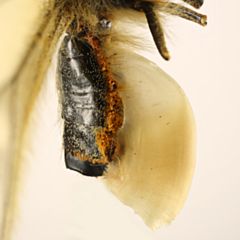Project 3836: A. P. S. Carvalho, A. G. Orr, A. Y. Kawahara. 2017. A review of the occurrence and diversity of the sphragis in butterflies (Lepidoptera, Papilionoidea). ZooKeys. 694:41-70.

Specimen: Parnassius mnemosyne (Linnaeus, 1758) (Florida Museum of Natural History)
View: Lateral
View: Lateral
Abstract
Males of many butterfly species secrete long-lasting mating plugs to prevent their mates from copulating with other males, thus ensuring their sperm will fertilize all future eggs laid. Certain species have further developed a greatly enlarged, often spectacular, externalized plug, termed a sphragis. This distinctive structure results from complex adaptations in both male and female genitalia and is qualitatively distinct from the amorphous, internal mating plugs of other species. Intermediate conditions between internal plug and external sphragis are rare. The term sphragis has often been misunderstood in recent years, hence we provide a formal definition based on accepted usage throughout most of the last century. Despite it being a highly apparent trait, neither the incidence nor diversity of the sphragis has been systematically documented. We record a sphragis or related structure in 273 butterfly species, representing 72 species of Papilionidae in 13 genera, and 201 species of Nymphalidae in 9 genera. These figures represent respectively, 13% of Papilionidae, 3% of Nymphalidae, and 1% of known butterfly species. A well-formed sphragis evolved independently in at least five butterfly subfamilies, with a rudimentary structure also occurring in an additional subfamily. The sphragis is probably the plesiomorphic condition in groups such as Parnassius (Papilionidae: Parnassiinae) and many Acraeini (Nymphalidae: Heliconiinae). Some butterflies, such as those belonging to the Parnassius simo group, have apparently lost the structure secondarily. The material cost of producing the sphragis is considerable. It is typically offset by production of a smaller spermatophore, thus reducing the amount of male-derived nutrients donated to the female during mating for use in oogenesis and/or somatic maintenance. The sphragis potentially represents one of the clearest examples of mate conflict known. Investigating its biology should yield testable hypotheses to further our understanding of the selective processes at play in an ‘arms race’ between the sexes. This paper provides an overview, which will inform future study.Read the article »
Article DOI: 10.3897/zookeys.694.13097
Project DOI: 10.7934/P3836, http://dx.doi.org/10.7934/P3836
| This project contains |
|---|
Download Project SDD File |
Currently Viewing:
MorphoBank Project 3836
MorphoBank Project 3836
- Creation Date:
16 October 2020 - Publication Date:
26 October 2020 - Project views: 45142

This research
supported by
Authors' Institutions ![]()
- University of Florida
- Griffith University
Members
| member name | taxa |
specimens |
media | media notes |
| Ana Carvalho Project Administrator | 48 | 48 | 91 | 91 |
Project has no matrices defined.
Project views 
| type | number of views | Individual items viewed (where applicable) |
| Total project views | 45142 | |
| Project overview | 1171 | |
| Media views | 25702 | Media search (1901 views); M694027 (282 views); M694052 (237 views); M693996 (284 views); M694056 (252 views); M694037 (252 views); M694506 (248 views); M694019 (280 views); M694015 (291 views); M694020 (302 views); M694502 (194 views); M694009 (292 views); M693992 (308 views); M694512 (251 views); M694026 (294 views); M694012 (306 views); M694066 (245 views); M694004 (290 views); M694008 (299 views); M694010 (296 views); M694002 (297 views); M694032 (276 views); M694016 (304 views); M693946 (285 views); M694515 (209 views); M694513 (238 views); M694041 (207 views); M694035 (281 views); M694006 (300 views); M694021 (293 views); M694011 (301 views); M694017 (299 views); M693949 (302 views); M694511 (240 views); M694501 (236 views); M694046 (237 views); M694503 (215 views); M694509 (200 views); M694067 (234 views); M694500 (239 views); M694042 (226 views); M694065 (238 views); M694054 (268 views); M694034 (269 views); M694028 (291 views); M694505 (253 views); M694018 (274 views); M694063 (230 views); M694516 (230 views); M694050 (227 views); M694040 (263 views); M693947 (289 views); M694499 (256 views); M693997 (312 views); M693948 (284 views); M694038 (264 views); M693994 (302 views); M694045 (238 views); M694504 (226 views); M694000 (289 views); M694059 (235 views); M694007 (291 views); M694060 (237 views); M693950 (280 views); M694517 (230 views); M694514 (230 views); M694047 (235 views); M693951 (259 views); M693993 (299 views); M693995 (297 views); M693999 (300 views); M694001 (289 views); M694014 (285 views); M694022 (287 views); M694023 (304 views); M694025 (295 views); M694029 (267 views); M694030 (259 views); M694031 (263 views); M694033 (272 views); M694036 (275 views); M694043 (235 views); M694048 (234 views); M694049 (233 views); M694053 (232 views); M694055 (239 views); M694057 (243 views); M694062 (204 views); M694064 (237 views); M694507 (212 views); M694508 (204 views); M694510 (214 views); |
| Bibliography | 497 | |
| Specimen list | 14039 | |
| Views for media list | 1256 | |
| Taxon list | 2473 | |
| Documents list | 4 |
Project downloads 
| type | number of downloads | Individual items downloaded (where applicable) |
| Total downloads from project | 111 | |
| Project downloads | 111 |
